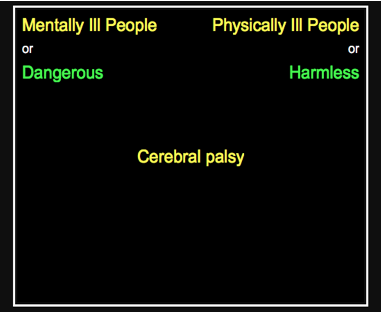
Credit: sprout_creative
There is often a contradiction between participants’ explicit vs. implicit beliefs regarding mental health. Project Implicit Mental Health explains that #ImplicitBias is discriminating without awareness of discriminating and how it impacts the way we think of others and ourselves, and, consequently, how it impacts our behavior.
Whenever there is a mass shooting in the United States there is generally, soon after, a nationwide discussion on ‘fixing the mental health problem’. Predicting this level of violence is incredibly challenging, yet mental illness becomes a quick focal point of discussion on how to end mass shootings, even though data does not support this analysis. There are numerous reasons for this that involve both explicit (conscious) and implicit (unconscious) bias. Jonathan M. Metzl, MD, PhD and Kenneth T. MacLeish, PhD, wrote in the American Journal of Public Health that in the aftermath of mass shootings, the term mentally ill stops being a medical classification and, instead, becomes a sign of violence threat.
One organization trying to understand bias toward people with mental illness is Project Implicit Mental Health (PIMH), the mental health sister-site of Project Implicit, a non-profit organization that aims to educate the public about hidden biases and is a virtual laboratory that collects data from numerous online implicit bias tests hosted by Harvard University. Miranda Beltzer, University of Virginia and PIMH researcher, says studies have shown a great deal of variability regarding mental illness stigma among the general public. For instance, one study found slightly positive explicit and implicit views toward people with mental illness (Peris, Teachman, & Nosek, 2008). In another study (college sample), participants’ explicit beliefs were that people with mental illness are bad and helpless, but not blameworthy. Their implicit beliefs, on the other hand, were that people with mental illness are bad, helpless, and blameworthy as compared to people with physical illness (Teachman, Wilson, & Komarovskaya, 2006).
While there is certainly variance, what’s clear is that there is often a contradiction between participants’ explicit vs. implicit beliefs. To understand why, we need to dig deeper into what is implicit bias and how it interacts with explicit beliefs, behaviors, and actions. Alexandra Werntz, University of Virginia and PIMH researcher, says implicit biases are simply automatic connections stored in a person’s mind outside of his/her conscious awareness. Contrarily, explicit biases are more familiar to people and are biases that people are able to identify and report. “They are influenced by a lot of different factors, like willingness to disclose and social desirability,” says Werntz. When thinking about implicit and explicit biases about mental health, she says to imagine the following scenario:
Person A has been getting lunch with the same coworker (Person B) for the past year. However, yesterday, Person B discloses that he has been seeing a therapist for the last six months because he has been feeling really down. After learning this information, someone asks Person A, “Do you think your coworker is bad or dangerous?” Person A may be inclined to say no—she knows it’s not socially desirable to be biased against people with mental illness. However, Person A may find herself not really wanting to go to lunch with this friend any longer.
The reason Person A may no longer want to have lunch with Person B is because she may have more automatic, less consciously controlled, associations between mental illness and concepts like danger.
Anthony Greenwald, cofounder of Project Implicit, describes implicit bias as discriminating without awareness of discriminating. Meaning, implicit bias is when people discriminate without intent to do so and without awareness that they are doing so. This results in their discrimination not only against others but also themselves. Greenwald says people’s minds work on two levels—one functions rationally and deliberately (explicit) while the other operates intuitively and automatically (implicit). The two levels aren’t entirely independent—the conscious level, he says, works with what it receives from the unconscious level, the basis for deliberate judgment and action.
In a presentation at the University of Washington, Greenwald turned to the Edward H. Adelson’s Checkershadow Illusion to illustrate the relationship between implicit and explicit thinking. In the graphic it appears that square A and B are not the same shade of gray when they are, in fact, the very same hue. It’s simply the context that makes people think otherwise. The viewer of the illusion has no idea how it’s happening or even awareness that an illusion is happening.

To determine implicit bias, Project Implicit examines automatic preference through a timed photo and/or word association Implicit Association Test (IAT). Project Implicit IATs focus on biases in an array of areas ranging from gender-career associations to age discrimination, while its mental health sister-site, PIMH, focuses specifically on mental health IATs. Users on the PIMH portal can take individual 10-minute tests to determine his/her implicit bias toward anxiety, depression, alcohol, eating disorders, or persons with mental illness. The tests primarily examine the participant’s true perceptions of himself/herself. A self-esteem test determines whether the user implicitly associates himself/herself as good or bad, the alcohol test examines whether the user thinks alcohol is irresistible, and the treatment test gets at whether the user implicitly favors medication over talk therapy.
The PIMH portal also hosts a mental illness test that examines whether the participant implicitly thinks people with mental illness are dangerous. The test solely uses questions and word associations to determine explicit and implicit bias. The first portion focuses on explicit beliefs by asking participants numerous questions on his/her felt safety around people with mental illness. Questions include whether the participant would allow his/her children to go to the movie theatre alone if a group of former mental patients lived nearby. Participants are also asked whether he/she would recommend a qualified person for a teaching position at a grade school if the person had been a former mental patient. Other questions include whether the participant would be less likely to trust a person that had been a mental patient and whether he/she believes mental health hospitals’ main purpose is to protect the public from mentally ill people.
The second portion of the test hones in on implicit bias through quick word associations, where the user presses ‘E’ (for left) or ‘I’ for (right) in order to match a word with a category. The left and right categories change. At some point the test puts mentally ill people + harmless on the left and physically ill + dangerous on the right. At another point the categories are listed opposite, where mentally ill people + dangerous are on the left and physically ill + harmless on the right. (See Figures 1 and 2.) It’s repetitive and easy, pulling out the user’s automatic associations. The more a participant associates certain words, the more rapidly he/she responds. The words the participant organizes under the changing categories include dangerous, unsafe, violent, aggressive, harmless, safe, peaceful, gentle, Schizophrenia, Bipolar Disorder, Depression, Obsessive-Compulsive Disorder, Diabetes, Appendicitis, Cerebral Palsy, and Multiple Sclerosis.
Figure 1. Physically Ill People + Dangerous (right) and Mentally Ill People + Harmless (left)

Source: PIMH
Figure 2. Mentally Ill People + Dangerous (left) and Physically Ill People + Harmless (right)

Source: PIMH
People who participated in PIMH mental health studies between 2011 and 2015 explicitly responded that people with mental illness are slightly to moderately harmless. However, participants had slightly stronger implicit beliefs that people with mental illness are dangerous as compared to physically ill people. The result highlights that bias toward those with mental illness persists even though mental illness is common. “More than a quarter of Americans have a diagnosed mental illness (26.2%[1] of Americans over the course of a year will meet criteria for mental illness),” says Beltzer. “Nearly half[2] of Americans at some point in their life will meet full criteria for mental illness.” Implicit bias may factor into why people say they see therapy as a more effective form of treatment than medicine but are more apt to use medication over therapy. “The most common number of times people go to a therapist is once,” says Beltzer. “They go to a single session and don’t return.” Certainly, there are numerous reasons for this contradiction—cost, time, and transportation—but stigma and bias are part of the calculus.
What is interesting, but not necessarily surprising, are the many contradictions there are in people’s implicit vs. explicit mental health associations regarding themselves. For example, Alcohol PIMH study participants explicitly reported that they more strongly thought of themselves as abstainers, as opposed to drinkers. Yet, participants did not have an implicit bias toward automatically thinking about themselves as being drinkers or abstainers. Older age correlated with stronger implicit self-concepts of being an abstainer but stronger explicit self-concepts of being a drinker. Werntz says this may be a result of people’s implicit and explicit drinking identities. “Kristen Lindgren, PhD, Associate Professor, University of Washington, has found that for explicit drinking associations, considering oneself as an abstainer may be protective for adults under 25, as compared to adults over 25,” says Werntz. “This suggests that what people say in terms of their drinking identity is especially important for younger adults.” (See more on drinking identity at Lindgren et al., 2016.)
Participants in the Anxiety PIMH study were quicker to automatically (implicitly) associate themselves with being calm than anxious. However, they did explicitly report that they more strongly thought of themselves as anxious, rather than calm. This contradiction may, in part, says Werntz, be because participants chose to participate in this particular test and thereby may already think of themselves as anxious individuals. The same she suspects is true for the Depression PIMH study where participants implicitly associated themselves with being happy, rather than sad. Yet, participants explicitly reported that they more strongly thought of themselves as being sad than happy. “Individuals who participated in the depression study were already interested in depression, so may be more willing to report being sad,” says Werntz “And because they were reporting anonymously, stigma may not have been a factor when deciding how to respond.”
Interestingly, Werntz says PIMH research has shown that people are, overall, more likely to implicitly associate themselves with positive attributes, which may play a role in large group averages and responses. Research also suggests that implicit associations and biases become particularly important in predicting behavior when people are low on cognitive resources. One study found, says Werntz, that implicit biases about alcohol were more predictive of drinking alcohol when participants’ self-control resources were depleted, as compared to participants who had more resources for self-control (Ostafin, Marlatt, & Greenwald, 2008). Meaning, people may default to their automatic associations (implicit associations) as opposed to their rational mind (explicit associations) when they are cognitively drained.
Sometimes people’s implicit and explicit biases are in line with each other, says Werntz, but sometimes they diverge. “When they diverge, it’s important to stop and think about why this might be the case,” says Werntz. “We’re not saying that one is necessarily the truth—it’s just that implicit biases and explicit biases exist and interact in ways that we’re still figuring out.” As PIMH researchers learn more about negative implicit biases they also begin to ponder how to positively alter them. Unfortunately, says Werntz, thus far, Project Implicit is not aware of any evidence-based interventions to shift implicit bias about mental illness. What researchers do know, says Beltzer, is that people with mental health training have more positive implicit and explicit views of people with mental illness than the general public (Peris, Teachman, & Nosek, 2008). This can be for a variety of reasons, says Beltzer, such as exposure, self-selecting into that career, and training-information.
People don’t need to become experts in mental illness to dispel their own biases. Research indicates that exposure to people with mental illness, says Beltzer, makes people think of those with mental illness in less negative ways (Phelan & Link, 2004). Simply learning that a best friend or a family member has panic attacks or is depressed may counter negative implicit bias. Werntz’s recommends encouraging people to learn about their own implicit bias. Just this knowledge alone, she says, can get people to think critically about whether these biases are in line with their principles. “The more people are aware of their own biases, the more they may be able to slow down and act in ways that are aligned with their values.” For instance, if we revisit the example where Person B shared with Person A that he was feeling down and was seeing a therapist, Person A may behave differently if she learns more about her implicit bias. Meaning, if she learns that she implicitly thinks of individuals with mental illness as dangerous but doesn’t want to act in a way to discriminate against people with mental illness, she could make the conscious effort to continue to go to lunch with her friend. Over time, says Werntz, Person A would hopefully become more and more comfortable.
[1] Kessler, R. C., Chiu, W. T., Demler, O., & Walters, E. E. (2005). Prevalence, Severity, and Comorbidity of Twelve-month DSM-IV Disorders in the National Comorbidity Survey Replication (NCS- R). Arch Gen Psychiatry, 62(6), 617–627. http://doi.org/10.1001/archpsyc.62.6.617
[2] Kessler, R. C., Berglund, P., Demler, O., Jin, R., Merikangas, K. R., & Walters, E. E. (2005). Lifetime Prevalence and Age-of-Onset Distributions of DSM-IV Disorders in the National Comorbidity Survey Replication. Arch Gen Psychiatry, 62(June), 593–602. http://doi.org/10.1001/archpsyc.62.6.593
This post was originally published on the National Association of State Mental Health Program Directors (NASMHPD) website.
